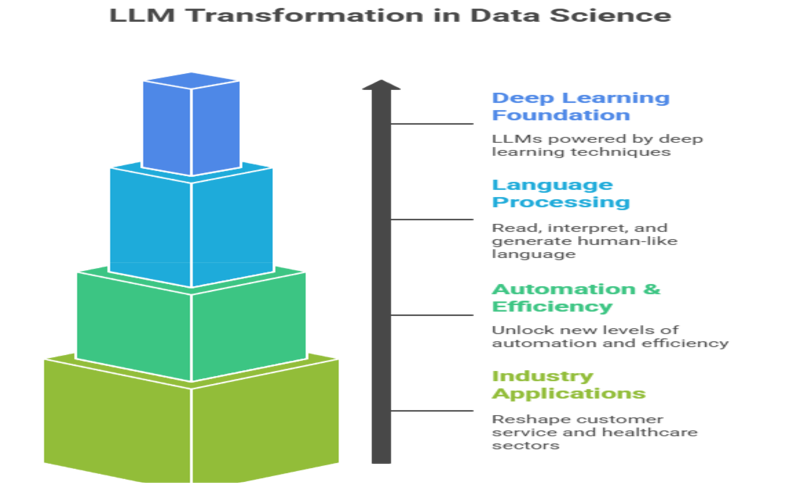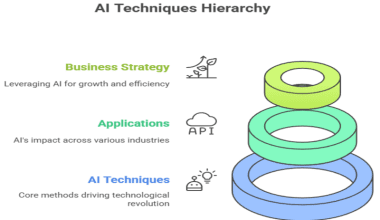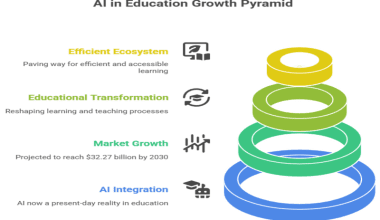Summary: Large language models (LLMs) are reshaping data science through automation, language generation, and real-time analytics. From customer service to fraud detection, LLMs drive efficiency, insight, and innovation. This guide explores how LLMs work, their applications, and use cases across industries, helping individuals and businesses unlock their full potential.
Introduction
Large language models (LLMs) are transforming data science by unlocking new levels of automation, insight, and efficiency. Harnessing the power of deep learning, these advanced AI systems can read, interpret, and generate human-like language at remarkable scale.
Their adoption is reshaping everything from customer service to healthcare, ushering in an era where language-driven data is as easily analyzed as numbers.
This comprehensive guide explores what large language models are, how they work, where they’re applied in data science, practical use cases, and the immense value they offer organizations positioned to leverage them.
Key Takeaways
- LLMs use transformers to process and generate language with human-like accuracy.
- Automate content creation, data analysis, and customer support using LLMs.
- LLMs deliver value across industries like healthcare, finance, and education.
- Sophisticated self-attention allows deep contextual understanding of natural language.
- Fine-tuned LLMs offer domain-specific insights and hyper-personalized AI solutions.
What Is a Large Language Model (LLM) in AI?
A large language model (LLM) is a sophisticated artificial intelligence tool designed to understand, generate, and manipulate human language. Powered by transformers and trained on enormous datasets spanning books, articles, websites, and more, LLMs can mimic human communication with subtlety and context. The most recognized LLMs today include:
- OpenAI’s GPT series
- Google’s Gemini
- Meta’s Llama models
With billions (or even trillions) of parameters, LLMs excel at:
- Recognizing and interpreting complex language patterns
- Summarizing, translating, or generating linguistic content
- Answering questions or holding interactive conversations
These capabilities empower businesses and individuals to automate processes that were previously labor-intensive, from customer support to content generation to data analysis.
How Do LLMs Work?
Large Language Models (LLMs) process and understand human language using advanced deep learning techniques—primarily transformers. Here’s how they function at a technical and conceptual level:
1. Transformer Neural Networks
At the core of LLMs is the transformer architecture, a type of neural network that excels at analyzing sequences of data, such as words in a sentence. This model uses layers of self-attention mechanisms, enabling the network to assess the importance of each word relative to all others in the sequence—both before and after the current word.
- Self-Attention: Evaluates relationships and dependencies between words, allowing nuanced understanding of meaning and context even in lengthy documents.
- Parallelization: Transformers process all elements of a sequence simultaneously, rather than word-by-word, making training and inference much faster and more efficient than previous models like RNNs.
2. Tokenization and Embeddings
LLMs convert raw text into tokens—units that could be words, subwords, or characters. Each token is then represented as a multi-dimensional vector, known as an embedding, which captures subtle syntactic and semantic information.
- Tokenization: Breaks down input text for the model to process.
- Embeddings: Translate tokens into numerical form, retaining the relationships between words and their meanings.
3. Training on Massive Datasets
LLMs are trained using unsupervised or semi-supervised learning on huge text corpora, including books, websites, code, news, and forums. Training on diverse and large-scale data enables the model to learn grammar, facts, styles, reasoning, and even world knowledge.
4. Contextual Understanding
Thanks to their deep layers and attention mechanisms, LLMs excel at contextual understanding—interpreting the meaning of words and phrases based on previous text. This allows them to generate coherent paragraphs, answer questions accurately, summarize documents, and translate languages effectively.
5. Fine-Tuning and Adaptation
While foundational LLMs are trained on broad data, they can be fine-tuned on domain-specific datasets (e.g., medical records, financial documents) to specialize in industry jargon and tasks, improving their relevance and accuracy for targeted applications.
Example
OpenAI’s GPT-3, a well-known LLM, uses 175 billion parameters and a transformer-based architecture. When given a prompt, it predicts the next word based on everything it has previously learned and the context of the input, enabling tasks like content generation, summarization, code completion, and Q&A.
Real World Examples of LLMs
Real-world applications of large language models (LLMs) are delivering transformative value across industries in 2025. Below are prominent LLM use cases, with examples and the kinds of impact they offer:
1. AI Agents for End-to-End Automation
AI agents powered by LLMs are moving beyond simple chatbots to automate entire workflows. These agents:
- Interact with multiple business applications.
- Generate code for integrations.
- Update databases, and
- Synthesize information across systems.
Example
When a client emails for a project update, an LLM-powered agent extracts the key request, checks project software, gathers data, drafts a summary, and writes a professional response—all autonomously. In insurance, AI agents now process claims from document extraction to drafting customer communications.
2. Automated Content & Text Generation
LLMs generate high-quality content such as blog posts, emails, product descriptions, reports, and technical documentation. They can produce coherent, audience-tailored writing at scale and in multiple languages.
Example
LLMs create product marketing copy or press releases that highlight features for target demographics with minimal human intervention.
3. Conversational and Customer Support Agents
LLMs drive advanced chatbots and virtual assistants capable of holding nuanced and helpful conversations, automating customer service, ticketing, FAQs, and lead capture.
Example
Enterprise customer support agents resolve common queries in real time, escalate complex cases to humans, and improve customer satisfaction metrics—all while reducing support costs.
4. Automated Code Generation & Explanation
LLMs generate, refactor, and even debug code based on natural language prompts, speeding up software development from prototyping to production.
Example
Developers request Python functions for data analysis or integrations, and the LLM returns ready-to-use, well-documented code.
5. Summarization & Knowledge Management
LLMs summarize long documents, reports, or datasets, distilling key points and supporting quick decision-making. This accelerates research, compliance, due diligence, and competitive analysis.
Example
Executives receive daily summaries of industry news or regulatory updates, automatically generated by language models based on huge streams of incoming data
The Future of LLMs in Data Science
The capabilities of large language models are expanding rapidly. With ongoing research and exponential increases in data and computational power, future LLMs will understand context more deeply, minimize bias, and enable entirely new categories of data-driven innovation.
Businesses integrating LLMs today are leading the shift toward an AI-powered future, where data science is faster, more accessible, and delivers value at unprecedented scale.
Frequently Asked Questions
What is an LLM in AI?
An LLM in AI is a large language model—a deep learning-based system trained on massive text datasets. These models comprehend and generate human language, powering applications like chatbots, content automation, summarization, translation, and more, making them a cornerstone in advancing artificial intelligence.
How is LLM used in data science?
LLMs are employed in data science to automate text processing, sentiment analysis, data labeling, document summarization, and anomaly detection. They enable efficient handling of large, complex textual datasets, improve insight generation, and accelerate data science workflows across industries such as healthcare, finance, and retail.
Who benefits from using LLM in data science?
Data scientists, analysts, businesses, and end users benefit from LLMs. These models enhance productivity by automating repetitive tasks, support faster data-driven decision making for organizations, and provide personalized, efficient services for customers, creating value across the data science ecosystem.
What are large language models used for?
Large language models are used for content generation, customer service automation, text classification, translation, data analysis, summarization, recommendation systems, fraud detection, and code generation, making them highly versatile assets in data science and AI-powered business transformation.
Conclusion
Large language models are redefining what’s possible in data science and artificial intelligence. By mastering large-scale language understanding, generation, and automation, LLMs create unparalleled opportunities for businesses and consumers alike. Whether you’re aiming to automate processes, extract deep insights, or power next-gen customer experiences, adopting LLMs offers a competitive edge in today’s data-driven world.



